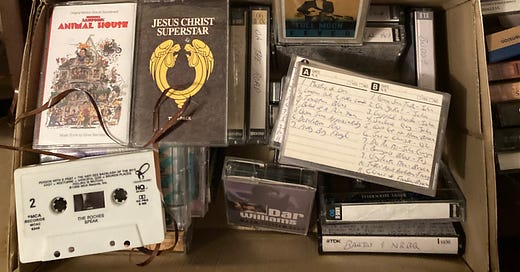The first time I became aware of the cassette format, in a customized do-it-yourself style, was in 1974, at a rockin’ party in Washington, D.C.
We were all dancing joyfully to hit after Motown hit, on a sound system that was way beyond putting a needle on vinyl via a record player. Nobody had to get up and move the needle past a song that wasn’t danceable.
“How did they do this?” I wondered. I had heard the future.
Fast forward 10 years. My future bride and I were in the New Haven basement apartment of our friend Eddie Petraiuolo III. We had decided we didn’t want a live band at our wedding; we liked the idea of a series of custom-made cassettes playing throughout the day. And so we presented Eddie with a list of our favorite songs and supplied him with the albums on which they appeared. He recorded our choices on about 12 cassettes, each 90 minutes long.
This was a long process. It began with my bride-to-be and I negotiating over which songs were acceptable — for instance, she vetoed Meat Loaf’s “Paradise by the Dashboard Light” because of its length and spoken parts. We debated at length over what song would be playing as we approached the minister. Finally we settled on “Everyday” by the late great Buddy Holly.
Each cassette had a theme and the time of day in which it would be played. As our friends gathered, they would hear the “Mellow” tape (James Taylor’s “Fire and Rain,” etc.) As a nod to my future father-in-law, we made a jazz tape. And we would finish the day and night with “Dancin’ Hits” (“Start Me Up” by the Stones, etc.)
Our sound system was a bit hit! Who needs a rock band, with jaded and bored hired musicians and their intermittent breaks?
In the years that followed I made many custom tapes of my own, and had a lot of fun doing it. I could group the selections: here’s Helen Reddy singing “I Am Woman,” followed by Gilda Radner doing her lampoon of the same song, followed by Tammy Wynette’s “D-I-V-O-R-C-E,” then Tom Jones belting out “Help Yourself (To My Lips).” I enjoyed knowing that my tapes were unique. There was nothing else quite like them anywhere. And once again I was able to hear songs from my vast collection of 45s! (What am I supposed to do with those old records? Put them on a juke box? Beats the hell out of me.)
But eventually I became aware that some of my cassette tapes were starting to sound a beat too slow and sometimes would stop playing and get eaten up by the boombox, the plastic unspooling. No! This couldn’t happen! And so I found a tech-savvy guy with a home studio who could convert my cassettes to compact discs. Presto! They sounded better. They couldn’t be eaten.
But I didn’t convert every tape; I had dozens of them and it was too much of a chore, too expensive.
However, within the last year the tape-eating has intensified. Eddie’s sister Kathy had long ago created an eclectic Christmas cassette for us — well, it got eaten up last year. Even after I bought a new cassette player, by Jensen (not recommended), two more of my cassettes were eaten. Fortunately, they were not my custom mades; I lost “Let It Roll” by Little Feat and “Speak” by the Roches. But come on!
Was it time to convert the remainder of my customized cassettes to CD? My greatest hits? My home studio guy had moved to Florida, so I turned to a company that offers format conversions. I selected 12 of my customized tapes that I really want to preserve and brought it to this service; I am awaiting delivery of 12 converted CDs. I’ll probably end up bringing them at least 12 more. But it ain’t cheap.
And yet there are people out there who love and still play their cassettes. It must be true — I read it in the New York Times. The story, which appeared last October, carried the headline “Cassettes Are Back.”
Marc Hogan reported: “The cassette’s return is by now almost as unmistakable as the format’s distinctive hiss and warble. Dominant in the U.S. from the early 1980s until it was overtaken by the compact disc in the early 1990s, the cassette tape has survived as an underground phenomenon, a deliberately anachronistic medium of choice for artists on the noise, avant-garde and low-fi fringes.”
I’m not quite sure what the hell he’s talking about (“low-fi fringes”?) But Hogan said that compared with vinyl records and CDs, “cassettes could be the cockroaches that outlive them all.”
However, Hogan acknowledged a problem cited in his subhead: “Now Find a Tape Deck.” He noted that “the best-known audio equipment manufacturers of the cassette era have long since exited the market.” These include Sony and Panasonic. And that left me having to buy a Jensen. I bought that after a previous Jensen and a player made by Studebaker (!) crapped out on me.
The cassette has given me decades of listening pleasure. But now I must kiss it goodbye. I have no choice. After all, it’s a terrible thing to have the music of your life eaten up.





I can remember spending hours creating just the perfect mix tape. Also, searching the stores for the Maxell tape that would produce the best sound. I didn't like the 90 minute tapes because they were thinner and I was always afraid they would break or get stuck in the player. If they did, I had my trusty pencil ready to rewind the tape.
And I thought I was bad hanging on to my cassettes, CDs, LPs, 45s and, yes, 78s! At least I bought the jukebox, a 1953 Seeberg, for those doo wop era 45s.